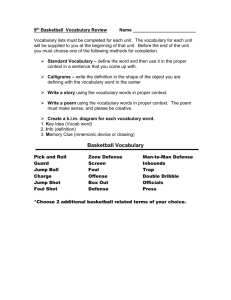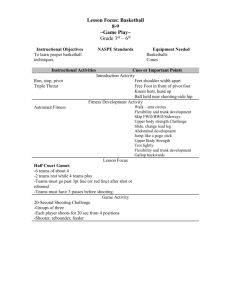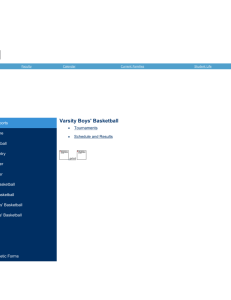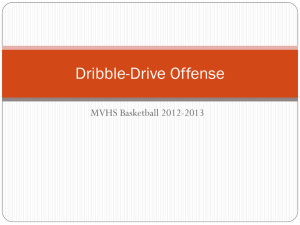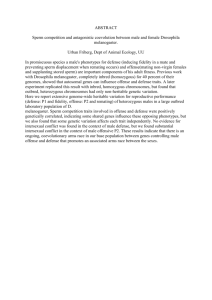phe.153.outline.s2011 - Student Learning Outcomes (SLO)
advertisement
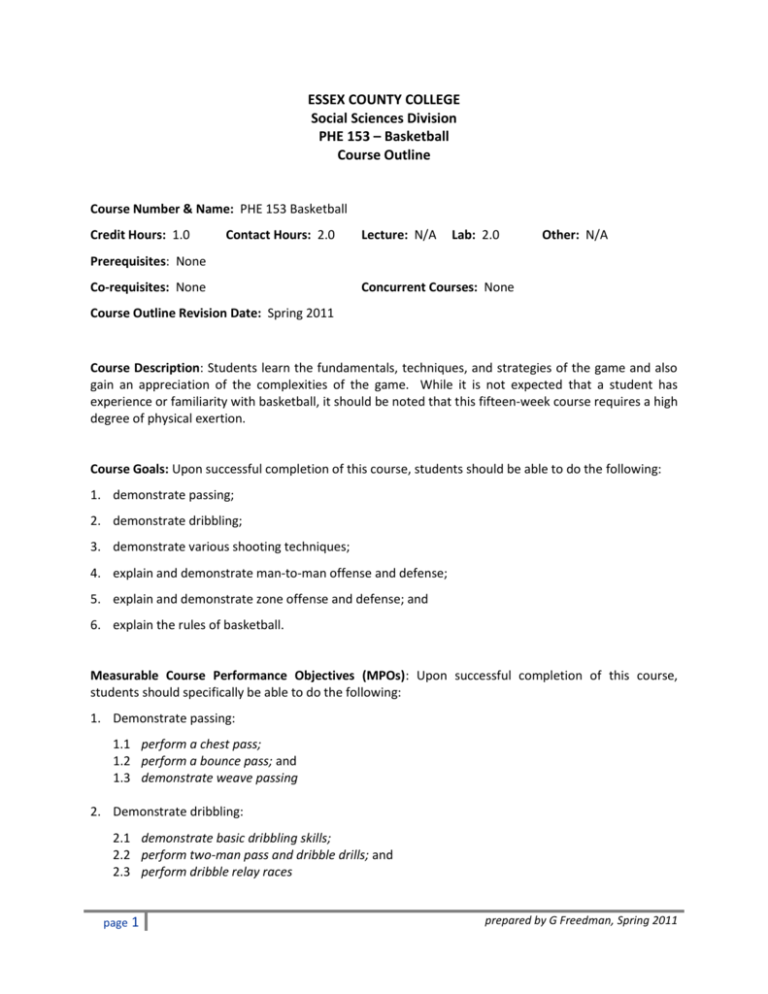
ESSEX COUNTY COLLEGE Social Sciences Division PHE 153 – Basketball Course Outline Course Number & Name: PHE 153 Basketball Credit Hours: 1.0 Contact Hours: 2.0 Lecture: N/A Lab: 2.0 Other: N/A Prerequisites: None Co-requisites: None Concurrent Courses: None Course Outline Revision Date: Spring 2011 Course Description: Students learn the fundamentals, techniques, and strategies of the game and also gain an appreciation of the complexities of the game. While it is not expected that a student has experience or familiarity with basketball, it should be noted that this fifteen-week course requires a high degree of physical exertion. Course Goals: Upon successful completion of this course, students should be able to do the following: 1. demonstrate passing; 2. demonstrate dribbling; 3. demonstrate various shooting techniques; 4. explain and demonstrate man-to-man offense and defense; 5. explain and demonstrate zone offense and defense; and 6. explain the rules of basketball. Measurable Course Performance Objectives (MPOs): Upon successful completion of this course, students should specifically be able to do the following: 1. Demonstrate passing: 1.1 perform a chest pass; 1.2 perform a bounce pass; and 1.3 demonstrate weave passing 2. Demonstrate dribbling: 2.1 demonstrate basic dribbling skills; 2.2 perform two-man pass and dribble drills; and 2.3 perform dribble relay races page 1 prepared by G Freedman, Spring 2011 Measurable Course Performance Objectives (MPOs) (continued): 3. Demonstrate various shooting techniques: 3.1 demonstrate the lay-up shot; 3.2 demonstrate the set shot; and 3.3 demonstrate foul shooting 4. Explain and demonstrate man-to-man offense and defense: 4.1 demonstrate guarding; 4.2 perform basic offense and defense plays; and 4.3 explain and demonstrate picks and screens 5. Explain and demonstrate zone offense and defense: 5.1 explain and demonstrate overloading and zone; 5.2 explain zone strategy; and 5.3 explain and demonstrate breaking and zone 6. Explain the rules of basketball: 6.1 6.2 6.3 6.4 6.5 6.6 explain players, substitutes, and team rules; explain shot clock and time limit rules; explain fouls, free throws, and violations rules; explain out-of-bounds and throw-in rules; explain putting-the-ball-in-play rules; and explain scoring rules Methods of Instruction: Instruction will consist of a combination of demonstration, skill work, practice sessions, games, and strategy applications. Outcomes Assessment: Test questions are blueprinted to course objectives. Checklist rubrics are used to evaluate skill and strategy performance for the presence and mastery of course objectives. Data is collected and analyzed to determine the level of student performance on these assessment instruments in regards to meeting course objectives. The results of this data analysis are used to guide necessary pedagogical and/or curricular revisions. Course Requirements: All students are required to: 1. Attend all classes on time and actively participate in class. 2. Take a written final test as scheduled. 3. Demonstrate skills as requested by the instructor. page 2 prepared by G Freedman, Spring 2011 Methods of Evaluation: Final course grades will be computed as follows: Grading Components % of final course grade Attendance & Class Participation Students need to attend and participate in class to benefit from the guidance of the instructor, to observe necessary demonstrations, and to practice basketball. 50% Final Written Test (date specified by the instructor) The test will provide evidence of the level of student mastery of the rules and basic techniques involved in basketball. 25% Skill Evaluations Skill evaluations will provide evidence of student mastery of physical performance-based course objectives. 25% Academic Integrity: Dishonesty disrupts the search for truth that is inherent in the learning process and so devalues the purpose and the mission of the College. Academic dishonesty includes, but is not limited to, the following: plagiarism – the failure to acknowledge another writer’s words or ideas or to give proper credit to sources of information; cheating – knowingly obtaining or giving unauthorized information on any test/exam or any other academic assignment; interference – any interruption of the academic process that prevents others from the proper engagement in learning or teaching; and fraud – any act or instance of willful deceit or trickery. Violations of academic integrity will be dealt with by imposing appropriate sanctions. Sanctions for acts of academic dishonesty could include the resubmission of an assignment, failure of the test/exam, failure in the course, probation, suspension from the College, and even expulsion from the College. Student Code of Conduct: All students are expected to conduct themselves as responsible and considerate adults who respect the rights of others. Disruptive behavior will not be tolerated. All students are also expected to attend and be on time for all class meetings. No cell phones or similar electronic devices are permitted in class. Please refer to the Essex County College student handbook, Lifeline, for more specific information about the College’s Code of Conduct and attendance requirements. page 3 prepared by G Freedman, Spring 2011 Course Content Outline: There is no text for this course. Week Topics 1 Passing Drills 2 Dribbling Drills 3 Three-Man Weaves 4 Lay-Up Shots 5 Basic Shooting Techniques 6–7 Shooting Drills with Lead-Up Shooting Games 8–9 Man-to-Man Offense and Defense Plays 10 – 11 Zone Offense and Defense Plays 12 – 13 Lead-Up Games and Regulation Games 14 – 15 Skills Tests Final Written Test page 4 prepared by G Freedman, Spring 2011
